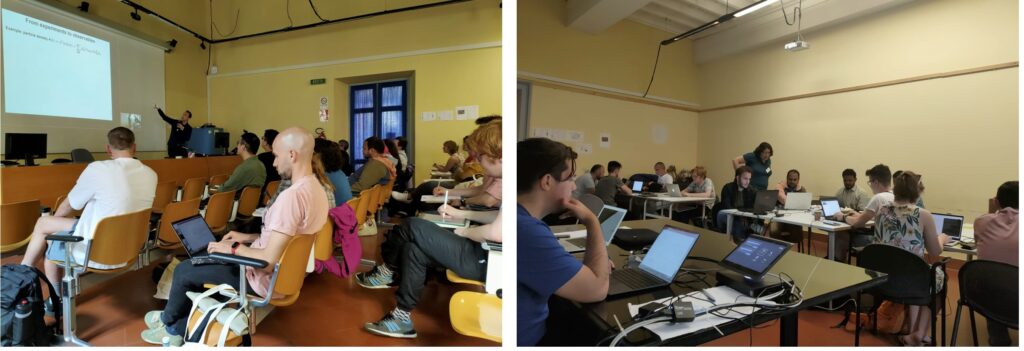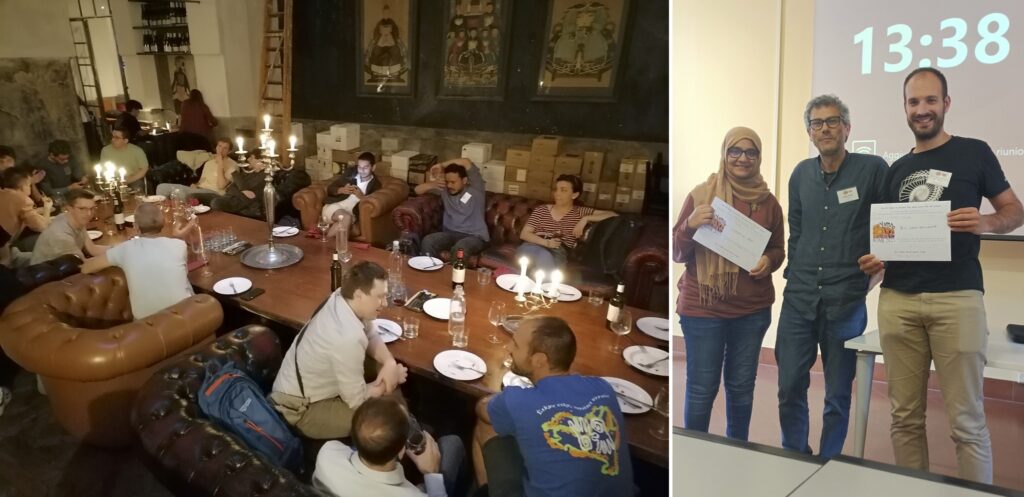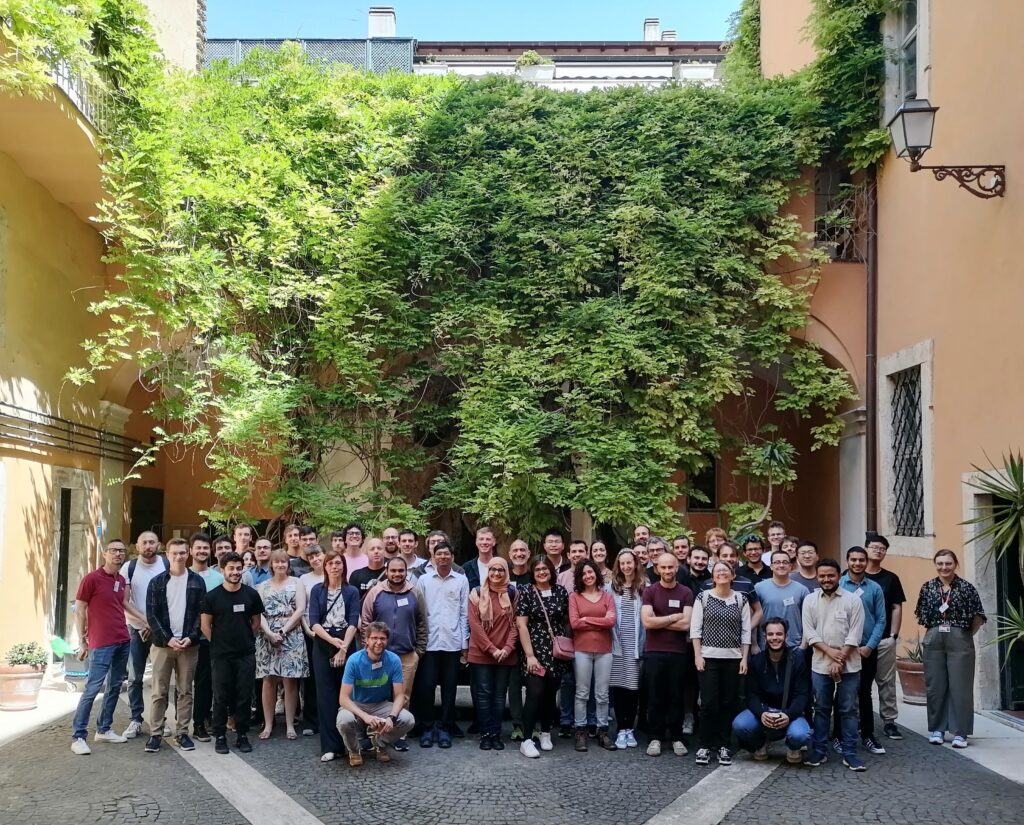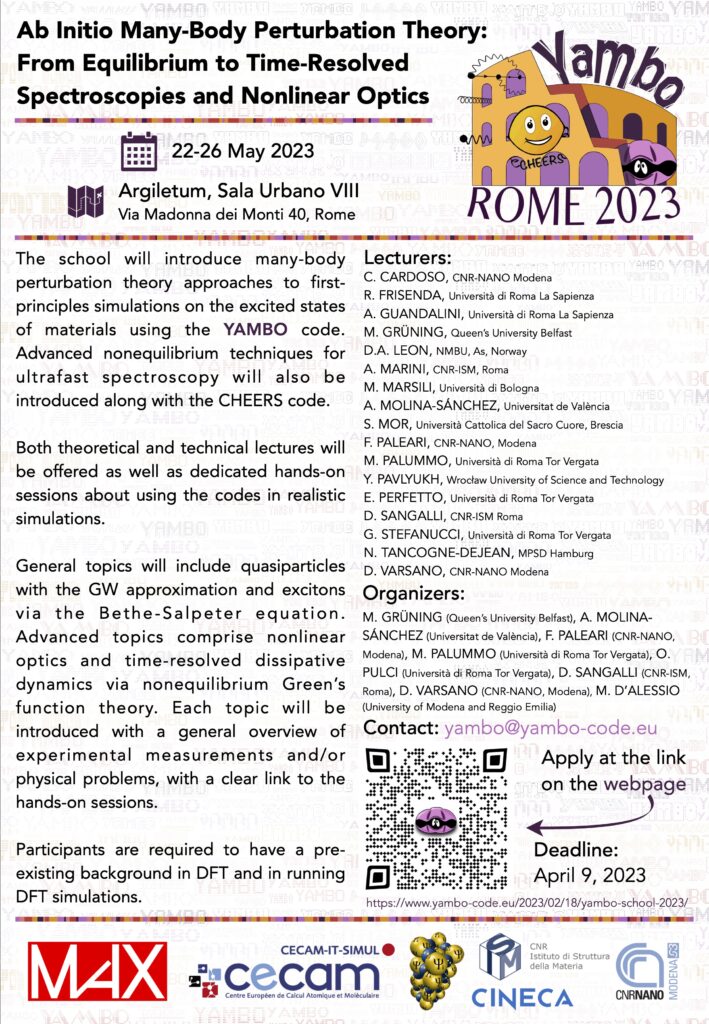The school, themed “Ab initio many-body perturbation theory: from equilibrium to time-resolved spectroscopies and nonlinear optics,” took place from May 22nd to May 26th, 2023. The event took place in the captivating setting of Argiletum, located at the heart of Rome’s city centre. The school was made possible through the sponsorship of the MaX Centre of Excellence — Materials Design at Exascale–, the Italian Cecam-IIT Simul node, and the Psi-k network. It brought together 39 participants from various countries, representing a diverse and inclusive community. The aim of the school was to provide comprehensive training on theoretical and computational methods, with a specific focus on the YAMBO code and its recent advancements.
Among the 39 participants, 12 countries were represented, fostering a diverse and inclusive environment. The attendees comprised of 71.8 Master or PhD students, 23.1 % postdocs, and 5.1 % faculties. The school drew a balanced participation, with an estimated distribution of 76.9 % males and 23.1 % females, reflecting the commitment to gender equality.
The primary objective of the school was to equip participants with theoretical and computational skills to explore excited properties, focusing on recent advancements in the YAMBO code. Additionally, the school aimed to familiarize students with nonequilibrium Green’s function theory (NEGF) through theoretical lectures that covered modern pump-and-probe experiments utilizing ultra-short laser pulses, as well as nonlinear
In the mornings, students attended lectures that covered the fundamentals of linear response, many-body perturbation theory (MBPT), and non-equilibrium Green’s function theory (NEGF). A dedicated session was introduced to real-time MBPT methods and simulations, which enabled the exploration of electronic correlation beyond linear response using the YAMBO and CHEERS codes. The school aimed to provide students with the essential knowledge, practical skills, and computational tools required to address the novel and challenging problems in materials science and non-equilibrium physics. It also discussed how model systems can help overcome limitations associated with fully ab initio schemes.
The school featured theoretical, experimental and technical lectures in the mornings, delivered by distinguished scientists and emerging young researchers in the field of condensed matter and non-equilibrium physics. The lectures provided a theoretical background and an overview of the topics, including their connection to the simulations conducted in the afternoon hands-on sessions. These hands-on sessions were led by the main developers of the YAMBO and CHEERS codes.
During the hands-on sessions in the afternoons and the Friday morning session, attendees put into practice the approaches and computational tools introduced earlier in the day. They gained familiarity with the Yambo code and its implementation within first principles through the calculation of excited state properties. The tutorials focused on hexagonal boron nitride, covering both bulk and single-layer configurations. To facilitate the hands-on sessions, participants were provided access to the Marconi100 supercomputer, with support from CINECA. All software and codes were prepared to ensure a smooth tutorial experience. Moreover, students were encouraged to run parallel jobs to test the parallelization schemes of Yambo and evaluate the code’s performance.

The first evening also hosted a welcome apéritif for participants with the aim to get to know each other, networking and discuss their current research projects. A social dinner was organized on Wednesday evening at “Osteria della Suburra”.
On the final day of the school, students had the opportunity to present their research in a slide-poster session. Each student showcased their poster in a brief 5-minute talk, followed by a question-and-answer session. During the coffee break, students exchanged ideas about their research projects with the developers and fellow participants.
During the final day, an interactive Question/Answer session, named the “Yambo Helpdesk,” was organized. This session provided an invaluable opportunity for participants to seek guidance from the expert lecturers on how to effectively apply Yambo to their individual research projects. The participants posed a wide range of inquiries, spanning from seeking general advice on the most suitable approximation for their specific system to inquiries regarding the installation of the code on their personal machines. Additionally, participants sought insights into the optimal configuration and suggestions for running Yambo on parallel High-Performance Computing (HPC) machines.
At the end of the school, two proactive students were awarded a prize consisting in a certificate of recognition and a classical book of Many Body Perturbation Theory and electronic structure methods.

Program and links to videos and tutorials:
Monday, May 22
D. Varsano, CNR-NANO Modena
Description and goals of the school: From theoretical concepts to real computation of the excited states properties of complex materials by first principles
slides video
G. Stefanucci, Università di Roma Tor Vergata
The Many-Body Problem: Key concepts of the Many-Body Perturbation Theory
slides video
M. Marsili, Università di Bologna
Beyond the independent particle scheme: The linear response theory
slides video
Hands-on:From the DFT ground state to the complete setup of a Many Body calculation using Yambo
Tuesday, May 23
E. Perfetto, Università di Roma Tor Vergata
An overview on non-equilibrium Green Functions
slides video
R. Frisenda, Università di Roma La Sapienza
ARPES spectroscopy, an experimental overview
slides video
A. Marini, CNR-ISM Roma
The Quasi Particle concept and the GW method
slides video
A. Guandalini, Università di Roma La Sapienza
The GW method: approximations and algorithms
slides video
D.A. Leon, NMBU, As, Norway
C. Cardoso, CNR-NANO Modena
Frequency dependence in GW: origin, modelling and practical implementations
slides video
Wendsday, May 24
A. Molina-Sánchez, Universitat de València
Modelling excitons: from 2D materials to Pump and Probe experiments
slides video
M. Palummo, Università di Roma Tor Vergata
The Bethe-Salpeter equation: derivations and main physical concepts
slides video
F. Paleari, CNR-NANO Modena
Real time approach to the Bethe-Salpeter equation
slides video
D. Sangalli, CNR-ISM Roma
TD-HSEX and real-time dynamics
slides video
Hands-on: Bethe-Salpeter Equation BSE
Thursday, May 25
S. Mor, Università Cattolica del Sacro Cuore, Brescia
Time resolved spectroscopy: an experimental overview
slides video
M. Grüning, Queen’s University, Belfast
Nonlinear optics within Many-Body Perturbation Theory
slides video
N. Tancogne-Dejean, MPSD, Hamburg
Theory and simulation of High Harmonics Generation
slides video
Y. Pavlyukh, Wrocław University of Science and Technology
Coherent electron-phonon dynamics within a time-linear GKBA scheme
slides video
Hands-on: Real-time approach with the time dependent berry phase
Hands-on: NEGF (I)
Friday, May 26
Hands-on: NEGF (II)
Poster session
Help desk, Prize Awards & final remarks
Lecturers:
Cardoso, CNR-NANO Modena
R. Frisenda, University of Rome La Sapienza
A. Guandalini, University of Rome La Sapienza
M. Gruning, Queen’s University Belfast
D.A. Leon, NMBU, As, Norway
A. Marini, CNR-ISM, Rome
M. Marsili, University of Bologna
A. Molina-Sanchez, Universitat de València
S. Mor, Università Cattolica del Sacro Cuore, Brescia
F. Paleari, CNR-NANO, Modena
M. Palummo, Università di Rome Tor Vergata
Y. Pavlyukh, Wrocław University of Science and Technology
E. Perfetto, University of Rome Tor Vergata
D. Sangalli, CNR-ISM Rome
G. Stefanucci, University of Rome Tor Vergata
N. Tancogne-Dejean, MPSD Hamburg
D. Varsano, CNR-NANO Modena
Tutors:
G. Sesti, CNR-NANO Modena
R. Reho, University of Utrecht
M. D’Alessio University of Modena and Reggio Emilia
Scientific Committee:
Daniele Varsano (CNR-NANO Modena)
Myrta Grüning (Queen’s University, Belfast)
Maurizia Palummo (University of Rome Tor Vergata
Davide Sangalli (CNR-ISM, Rome)
Fulvio Paleari (CNR-NANO Modena)
Alejandro Molina-Sánchez (University Of Valencia)
Organizing Committee:
Daniele Varsano (CNR-NANO Modena)
Maurizia Palummo (University of Rome Tor Vergata)
Davide Sangalli (CNR-ISM, Rome)
Olivia Pulci (University of Rome Tor Vergata)
Matteo D’Alessio (University of Modena and Reggio Emilia)
Maria Bartolacelli (CNR-NANO, Modena)
Susanna Cavicchioli (CNR-NANO, Modena)
Lectures and tutorials
Description and goals of the school: From theoretical concepts to real computation of the excited states properties of complex materials by first principles
Daniele Varsano, CNR-Nano, Modena, Italy
Dr. Daniele Varsano, gave an overview of the motivations of the school and some historical remarks about Yambo. By introducing the school motivations, he slowly entered the world of electronic correlation, the real cornerstone of modern excited state simulations in realistic materials. The main limitations, approximations, potentialities and, more in general, features of Yambo were addressed and discussed. Daniele created a collaborative and open atmosphere where any student question is a good question!
The Many-Body Problem: Key concepts of the Many-Body Perturbation Theory
Gianluca Stefanucci, Università Tor Vergata, Italy
Prof. Stefanucci introduced the basics concepts of many-body perturbation theory applied to solid state physics like Green’s function theory, the use of Feynman diagrams in interacting systems. The Kadanoff-Baym equations (KBE) were also introduced, together with the physical interpretation of the Green function in equilibrium. Gianluca gave a stimulating talk in one of the cornerstone theories of the Yambo code.
Beyond the independent particle scheme: The linear response theory
Margherita Marsili, Università di Bologna, Italy
Dr. Marsili introduced the students to the response of a system to an external perturbation and how this delivers information regarding the intrinsic properties of a system. In this, Margherita discussed how the electronic states are perturbed by optical fields, and the link between the microscopic magnitudes of a solid state system and the macroscopic observables. She gave a pedagogical and formal overview of the density-density response function, fundamental for a meaningful understanding of the Yambo code functionalities.
An overview on non-equilibrium Green Functions
Enrico Perfetto, Università di Roma Tor Vergata
Prof. Perfetto introduced the theoretical tools to simulate ultrafast pump-probe experiments within the framework of the non-equilibrium Green’s function theory. He motivated why other approaches like the Boltzmann equations are insufficient to describe the coherent regime when the time of the dynamics is at the order of few attoseconds. He introduced the Generalized Kadanoff-Baym ansatz (GKBA) and the density matrix, explaining the coherent and incoherent regimes. This is the theory behind the code CHEERS, able to perform simulations of ultrafast dynamics in organic molecules, as well as behind the real-time module of the Yambo code.
ARPES spectroscopy, an experimental overview
Frisenda, Università di Roma La Sapienza
Dr. Frisenda gave an introductory lecture on angle-resolved photoemission spectroscopy from an experimental point of view. He explained the main concepts behind this experimental technique in different configurations and setups, highlighting what can be measured with the actual setups and the related main difficulties and limitations. Recent results obtained in his laboratory were also shown and discussed.
The Quasi Particle concept and the GW method
Andrea Marini, CNR-ISM, Monterotondo-Rome, Italy
In this lecture, Dr Marini introduced the concept of quasi-particle within the framework of the GW method. The basic approximations (three step model, sudden approximation) leading to the connection with the many-body spectral function were highlighted. Then, the theory of Green’s functions was discussed, as the natural theoretical framework to deal with the calculation of the interacting spectral function, together with the physical properties of the resulting self-energies.
The GW method: approximations and algorithms
A. Guandalini, Università di Roma La Sapienza
In this lecture, Dr Guandalini briefly derived the main equations governing the GW approach. Next he described the most common approximations needed to carry out a GW calculation, with an emphasis on the particular choices and implementations done in the Yambo code. New algorithms to accelerate convergences were illustrated, as well as the description of the main variables used in Yambo and tips for efficient calculations.
Frequency dependence in GW: origin, modelling and practical implementations
D.A. Leon, NMBU, Norway
C. Cardoso, CNR-NANO Modena
Dr. Claudia Cardoso illustrated the state-of-the art methodologies in dealing with the frequency dependence of the electronic screening in the GW approximation. She provided a rich overview of the most common approximations, ranging from the plasmon-pole model to the contour deformation technique, highlighting the virtues and limitations in terms of accuracy and computational burden. Finally, she illustrated a new scheme recently implemented in the Yambo code based in the multipole expansion of the dielectric screening, which is able to reach the accuracy of full frequency methods with a limited computational cost. Examples on the performance of MPA were also shown, showing recent results on paradigmatic semiconductors and metals.
Modelling excitons: from 2D materials to Pump and Probe experiments
A. Molina-Sánchez, University of Valencia
Dr. Molina-Sánchez gave an overview of the simulations of pump-and-probe experiments available in the Yambo code and the main ultrafast spectroscopy experiments. He revisited simulations performed with the real-time module of the Yambo code like the time-resolved Kerr angle spectroscopy in transition metal dichalcogenides, the time-resolved absorption in 2D materials and he introduced the simulations of time-resolved angle-resolved photoemission spectroscopy in materials with high exciton binding energy.
The Bethe-Salpeter equation: derivations and main physical concepts
M. Palummo, Università di Roma Tor Vergata
Prof. Palummo gave an overview of the Bethe-Salpeter formalism and its application to the optical properties of materials. In the introduction, the failure of the independent particle picture for optical absorption was presented with a few examples. Starting from Hedin’s equations, introduced in Tuesday’s lectures, the Bethe-Salpeter equation was then derived. By introducing the basis of electron-hole pairs, the formalism was reformulated as an algebraic problem.
Real time approach to the Bethe-Salpeter equation
F. Paleari, CNR-NANO Modena
Dr. Paleari proposed a complementary lecture to the overview given by prof. Palummo, deriving the Bethe-Salpeter equation from a real time formalism as an alternative to the one based on Hedin’s equation. The derivation enabled a discussion on different aspects of the Bethe-Salpeter equation, and set the ground for the forthcoming lectures on real-time dynamics. Moreover, the real time approach was used to introduce a discussion on the coupling of excitons with phonons in photoluminescence experiments, comparing the results of numerical simulations with experimental data on hBN and other layered materials.
TD-HSEX and real-time dynamics
D. Sangalli, CNR-ISM Roma
Taking advantage of the two lectures by Dr. Fulvio and by prof. Perfetto, Dr. Sangalli illustrated how the equation of motion (EOM) based on MBPT is implemented in the real time module of the yambo code (yambo_rt). It was shown how the results of the yambo_rt simulations can be used to obtain optical spectra. Successes and limitations of different levels of approximations to the time-dependent electron-hole interaction, which determines the linear and nonlinear optical properties of complex materials were also addressed, considering the simple Fermi Golden rule (RPA), functionals of the density (TD-DFT) and the polarization up to the HSEX functionals derived from MBPT. TD-HSEX was shown to give the same results of BSE. Finally, an overview is given on how the approach can be extended to describe pump and probe experiments, with few results on time-resolved angle-resolved photoemission (TR-ARPES) from excitonic states.
Time resolved spectroscopy: an experimental overview
S. Mor, Università Cattolica del Sacro Cuore, Brescia
Dr. Mor gave an overview on how pump and probe experiments can be used to measure different material properties with few selected examples. The lecture discussed both transient absorption spectra and time resolved and angle-resolved photoemission measurements in materials ranging from layered semiconductors to superconductors. Part of the discussion was also focused on two topics discussed in the theoretical lecture, e.g. the coupling of excitons with phonons, especially in the coherent regimen, and the detection of excitons in TR-ARPES.
Nonlinear optics within Many-Body Perturbation Theory
M. Grüning, Queen’s University, Belfast
Using a real-time approach, Dr. Grüning showed how to access non-linear spectroscopy through time-dependent polarization, given in terms of the Berry phase approach. He showed how the Fourier analysis of the real-time polarization can be used to calculate nonlinear optical properties, i.e. second and third harmonic generation, with the main focus on low-dimensional systems including 2D.
Theory and simulation of High Harmonics Generation
N. Tancogne-Dejean, MPSD, Hamburg
Dr. Tancogne-Dejean gave an overview of what can be measured in non-linear optics experiments by means of high intensity laser pulses. Going beyond the “perturbative regime”, where the response of the material is dominated by the lowest order response functions, high-harmonics generation (HHG) can be achieved. This regime cannot be described via response function. He gave an historical overview on how the approach evolved, starting from the first studies on isolated atoms and molecules, and introducing the first theoretical models proposed to describe this regime, followed by more recent first principles simulations. Finally, he discussed the very recent field of HHG in extended systems, with a few selected results obtained with the Octopus code.
Coherent electron-phonon dynamics within a time-linear GKBA scheme
Y. Pavlyukh, Wrocław University of Science and Technology
Dr. Pavlyukh discussed in details how dissipation and relaxation mechanisms can be introduced in the EOM for the one body density matrix of the system within the KBE-GKBA scheme, thus as an extension of the approach implemented in the real-time module of the yambo core. This approach is implemented in the CHEERS code where, by disregarding many details of the materials modeling, approximations beyond the TD-HSEX scheme. In particular, the inclusion of dynamical self-energies which capture relaxation and dissipation, however, making the scheme numerical demanding (simulation time scaling as total time propagation to the power 3). Starting from this, Pavlyukh discussed a re-writing of the EOM which allows obtaining a time linear scaling for KBE-GKBA for few selected self-enegies.
General remarks:
The school was initially designed to accommodate 30 participants, but due to the unexpectedly high level of requests for participation, efforts were made to increase the number of seats and accommodate 40 students. The participants of the school have shown remarkable enthusiasm by actively engaging in discussions, asking insightful questions, and providing valuable comments on various topics including general theory, practical implementation of the code, and, notably, the potential benefits of Many Body Perturbation Theory calculations for their own research. This highlights the increasing attraction of post-DFT calculations among a new generation of researchers, owing to their high accuracy. Furthermore, these events are highly sought after and appreciated, given the relative complexity of such calculations compared to standard DFT calculations
Feedback from participants:
At the end of the school, an anonymous feedback questionnaire was distributed to the participants. It was filled by 31 attendees (80% of the total). 64.5% indicated a level of satisfaction of 5/5 and 35.5% indicated 4/5. From the general comments and suggestions, great satisfaction emerges, especially concerning the organization and the atmosphere that was created during the school:
“I really appreciate the closeness of all the developers team.”
“The theoretical lectures on the foundations behind the Yambo code were really precious as someone who has not yet had the chance to use it. The more advanced lectures on non equilibrium were extremely stimulating.”
“The lectures helped me to clarify advanced concepts that are sometimes difficult to understand through books or articles. Being able to talk to experts in the field about specific questions has helped me a lot in my research. In addition, meeting other PhD/Post-docs who are working on the same thing as me helps me to know the state-of-the-art of what I do. Finally, it has also helped me to deepen my knowledge of Yambo/Yambopy, to be able to carry out more advanced simulations.”
“The lectures were organized in a perfect way, given first a brief introduction about the concepts, formulas and formalism necessary to follow the later lectures and also to understand the physical idea during the hands-on. The explanation of the concepts and how they can be implemented were in my opinion the useful part of the school”
“the lecture that the developer of yambo and the Instructors in general give is so good , especially to know that there are a whole “complicate it’ theory behind it and the point is not just to run yambo without understand what’s going on and what is the used approximation. Thanks Alot.”
“I really must applaud the availability and willingness of the organizers to help. They were very pleasant and patient, even when I asked perhaps trivial questions. It must have been tiring for them, but their enthusiasm didn’t wane. I am really thankful for this, well done!”
A suggestion that emerged from some of the students was to dedicate more time to the hands-on sessions and provide more basic knowledge in the theoretical lectures:
“I think everything as it is now is fine. A personal suggestion for improvement I think could be to modify the tutorials, with the aim of making them a bit shorter. This way, even if there are more tutorials on the website that are a continuation, for a person new to Yambo, it might be easier to retain basic concepts with shorter tutorials.”
“Difficult to improve, but I would dedicate a session to train or inform students on how to install the code. I think it is a not trivial thing that requires some time to understand. “
Conclusions and perspectives:
The school surpassed all expectations and achieved resounding success, evident from the overwhelming number of applicants eager to learn Many Body Perturbation Theory and gain hands-on experience with the Yambo code. The attendees exhibited exceptional proactivity and actively engaged in captivating discussions throughout the entire duration of the event. The choice of the lecture hall, situated in the heart of Rome, added to the allure, providing a captivating ambiance.
Social events, such as the warm get-together on the first day and the delightful social dinner, played a pivotal role in fostering a friendly and collaborative environment. The positive feedback and enthusiastic responses we received, coupled with the high demand for participation, have left us immensely motivated to organize similar schools in the upcoming years. We envision offering either a fundamental course on Many Body Perturbation Theory and Yambo usage, or an advanced school that explores new theories and the latest developments implemented in the code.
Further details:


